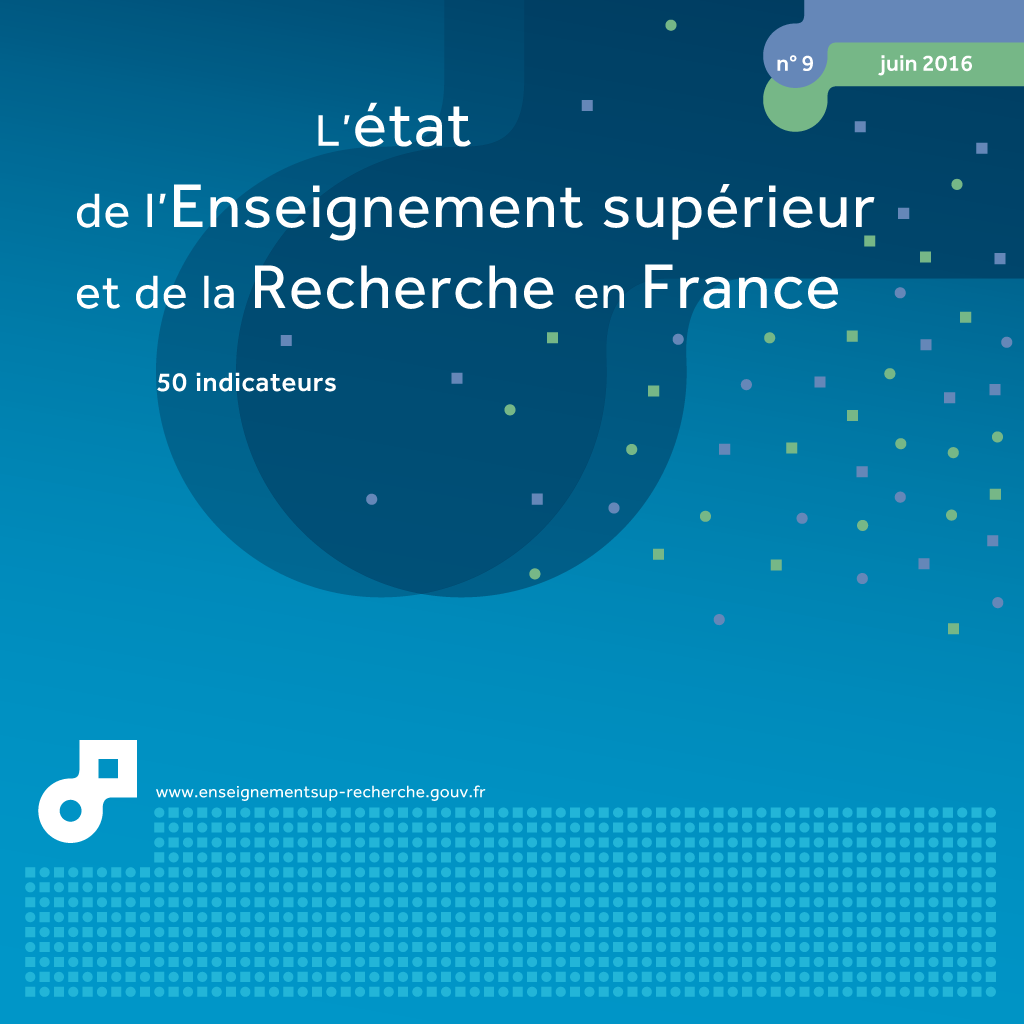36 human resources in research and development
This page has been updated. Read 35. human resources in research and development in Higher education & research in France, facts and figures 10th edition - June 2017
In 2013, over half a million people were involved in research activity in France. Women represented 30% of all research personnel and 26% of researchers. The number of researchers, 266,200 full-time equivalent (FTE) in 2013, has increased by 17% in five years. The number of researchers increased more rapidly in business enterprises (26%) than in government (5%) over the period 2008-2013.
In 2013, 575,300 people in France were involved in research-related activity. They represented 418,100 full-time equivalents (FTE), an increase of 9.3% in 5 years (table 36.01). The number of researchers increased by 16.9% in 5 years, from 227,700 FTE in 2008 to 266,200 FTE in 2013. The number of ancillary staff fell, however (-2.0% over 5 years). Researchers accounted for 64% of research staff in 2013, and the 'ancillary staff to researcher' ratio stood at 0.57 in 2013 compared to 0.68 in 2008.
In 2013, business enterprises employed 161,900 FTE researchers. These numbers had increased 26.1% since 2008. In the government sector, researcher numbers had grown less rapidly (+5.1% in 5 years) and stood at 104,300 FTE.
Since 2002, researchers in business enterprises have outnumbered those in government and in 2013 they represented 61% of all researchers.
Almost half of all research personnel in business enterprises (48%) are concentrated in five of the 32 branches of research (chart 36.02): 'Computer-related and information service activities' (12%), 'Manufacture of motor vehicles' (11%), 'Specialised scientific and technical activities' (10%), 'Manufacture of air and spacecraft and related machinery' (10%), 'Manufacture of instruments and appliances for measuring, testing and navigation; watches and clocks' (7%) (chart 36.02). Between 2008 and 2013, the number of researchers in the service branches increased 7 times more (+77%) than those working in industrial branches (+11%) and the "primary, energy and construction" branches (+15%).
The proportion of women working in research was 30% in 2013. This figure is lower for researchers (26%) than for ancillary staff (35%). It is also lower in business enterprises (22%) than in the government sector (40%).
In government, more than three out of four research personnel have permanent posts. There is a greater proportion of permanent staff among ancillary staff (88%) than among researchers (71%), as some researchers are doctoral students (chart 36.03).
In not-for-profit institutions, only 63% of research staff and 42% of researchers hold permanent posts.
Within the European Union, France is in second place for the number of researchers (FTE), behind Germany. The United Kingdom is in third position.
At global level, the European Union is ranked first, with 1.7 million FTE researchers, ahead of China (1.4 million) and the United States (1.3 million).
In relation to the active population, France had 9.13 researchers per thousand workers in 2013, behind South Korea and Japan, but ahead of the United States, Germany and the United Kingdom (chart 36.04). Several less populated countries rank among the world leaders, especially Finland, Taiwan and Sweden.
OECD.
How to cite this paper :
close
Key figures
people (headcount)
Whole of France
people (FTE)
Whole of France
people (FTE)
Whole of France
people (FTE)
Whole of France
people (FTE)
Whole of France
people (FTE)
Whole of France
people (FTE)
Whole of France
people (FTE)
Whole of France
people (FTE)
Whole of France
people (FTE)
Whole of France
people (FTE)
Whole of France
people (FTE)
Whole of France
people (FTE)
Whole of France
people (FTE)
Whole of France
people (FTE)
Whole of France
people (FTE)
Whole of France
people (FTE)
Whole of France
people (FTE)
Whole of France
Whole of France
people (FTE)
Whole of France
36.01 R&D personnel (FTE)
Break in series. From 2010, a change in methodology resulted in a reduction of around 6,000 FTE in government.
1 Semi-finalised data.
2 Including the French national centre for scientific research (CNRS).
You can embed this table to your website or your blog by copying the HTML code and pasting it into the source code of your website / blog:
close
36.02 Number of researchers per research branch in 2008 and 2013 1 (FTE)
1 Semi-finalised results.
The data on the graph show staff numbers in the 10 largest branches of research in terms of researchers in 2013. The other 22 branches are grouped together under the headings 'Other industrial branches' and 'Other service branches'.
You can embed this chart to your website or your blog by copying the HTML code and pasting it into the source code of your website / blog:
close
36.03 Breakdown of permanent staff among public sector and NPI R&D personnel in 2013 1 (%)
1 Semi-finalised data.
2 Including the French national centre for scientific research (CNRS).
3 Staff who are paid out of own funds are counted only in the 103 institutions with wider responsibilities and capacities in 2013. Doctoral students receiving pay and temporary research and teaching assistants (ATER) are counted in all institutions.
You can embed this chart to your website or your blog by copying the HTML code and pasting it into the source code of your website / blog:
close
36.04 Researchers as a proportion of the labour force in 2013 (in ‰)
The 23 countries shown are those with the most FTE researchers in 2013.
1 2012 data.
2 2011 data.
3 Semi-finalised data.
4 OECD estimate.
You can embed this chart to your website or your blog by copying the HTML code and pasting it into the source code of your website / blog:
close
Related statistical publications
 Note flash SIES 13 - L'emploi scientifique dans les organismes de recherche en 2015 - Louis Meuric - October 2016
Note flash SIES 13 - L'emploi scientifique dans les organismes de recherche en 2015 - Louis Meuric - October 2016 
 Etat de l'emploi scientifique en France - L'état de l'emploi scientifique en France - Isabelle Kabla-Langlois (dir.), Louis Meuric (ed.), Marie-Hélène Prieur (ed.), collective workJulien CalmandChristophe DixteLaurent FauvetDiane MarlatLaurent PerrainAnna TestasCynthia WavoékéOdile Wolber - September 2016
Etat de l'emploi scientifique en France - L'état de l'emploi scientifique en France - Isabelle Kabla-Langlois (dir.), Louis Meuric (ed.), Marie-Hélène Prieur (ed.), collective workJulien CalmandChristophe DixteLaurent FauvetDiane MarlatLaurent PerrainAnna TestasCynthia WavoékéOdile Wolber - September 2016 La nouvelle édition 2016 permet de mieux connaître la recherche menée dans les organismes et les établissements d'enseignement supérieur et celle réalisée en entreprise. En effet, le rapport 2016 intègre une approche de l'emploi scientifique par grands champs disciplinaires avec une consolidation ou une mise en cohérence des données portant sur les établissements d'enseignement supérieur, les organismes de recherche (EPST/EPIC) et les entreprises.
Les données statistiques sont présentées selon des périmètres, conventions et unités communs, conformément aux conventions internationales édictées par le manuel de Frascati, dans les limites de la disponibilité des données.
En outre, au-delà de la seule observation statistique, la publication intègre une dimension prospective, qu'il s'agisse du vivier des chercheurs (doctorants) ou des projections de départs en retraite.
Translation
 Etat de l'enseignement supérieur et de la rechercheL'état de l'Enseignement supérieur et de la Recherche en France n°9 - Juin 2016
Etat de l'enseignement supérieur et de la rechercheL'état de l'Enseignement supérieur et de la Recherche en France n°9 - Juin 201636 - les moyens humains de la recherche et développement - Catherine David






